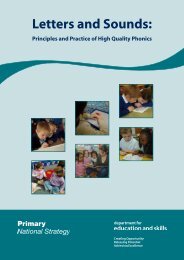Supporting young people with learning difficulties to participate and ...
Supporting young people with learning difficulties to participate and ...
Supporting young people with learning difficulties to participate and ...
Create successful ePaper yourself
Turn your PDF publications into a flip-book with our unique Google optimized e-Paper software.
Part 2 – The Learning L<strong>and</strong>scape<br />
2.1 Our aspirations are as high for <strong>young</strong> <strong>people</strong> <strong>with</strong> <strong>learning</strong> <strong>difficulties</strong> as they<br />
are for any other <strong>young</strong> person. All <strong>young</strong> <strong>people</strong> should have the opportunity <strong>to</strong><br />
<strong>participate</strong> in appropriate <strong>learning</strong> that leads <strong>to</strong> progression <strong>and</strong> positive outcomes,<br />
including employment.<br />
2.2 We want there <strong>to</strong> be a seamless system for identifying needs for all learners<br />
aged 0-25 years <strong>with</strong> Special Education Needs, placing responsibility <strong>with</strong> a single<br />
accountable body. Consistency of st<strong>and</strong>ards <strong>with</strong>in local flexibility will help <strong>to</strong><br />
ensure that all <strong>young</strong> <strong>people</strong> can benefit from the opportunities available <strong>and</strong><br />
ultimately progress in<strong>to</strong> employment regardless of where they live.<br />
15<br />
2.3 The Getting a Life project finds that aspirations are often far <strong>to</strong>o low for <strong>young</strong><br />
<strong>people</strong> <strong>with</strong> <strong>learning</strong> <strong>difficulties</strong> <strong>and</strong>/or disabilities, <strong>and</strong> that some post-16 assessments<br />
focus <strong>to</strong>o much on what <strong>young</strong> <strong>people</strong> cannot do rather than on what they can. The project<br />
suggests that there needs <strong>to</strong> be:<br />
• a greater emphasis on the voice of learners <strong>and</strong> their families at the local level;<br />
• employer engagement in the pathway for learners from year 9;<br />
• an emphasis on the needs of the individual throughout the Learning Difficulty<br />
Assessment process; <strong>and</strong><br />
• a consistent way <strong>to</strong> use the information coming from Action Plans centred on<br />
individual needs <strong>to</strong> inform strategic planning <strong>and</strong> commissioning.<br />
2.4 More than ever we need Learning Difficulty Assessments <strong>to</strong> be high quality <strong>and</strong><br />
consistently delivered, ensuring continuity <strong>and</strong> appropriateness of support when it is<br />
needed. This process should be actively supported by Children’s Trusts <strong>and</strong> Direc<strong>to</strong>rs of<br />
Children’s Services moni<strong>to</strong>ring the quality <strong>and</strong> sufficiency of the assessments produced<br />
through robust quality assurance systems operating in local authorities <strong>and</strong> commissioned<br />
services.<br />
Children’s Trusts<br />
2.5 The Children’s Trust is the sum <strong>to</strong>tal of co-operation arrangements <strong>and</strong> partnerships<br />
between organisations <strong>with</strong> a role in improving outcomes for children <strong>and</strong> <strong>young</strong> <strong>people</strong>.<br />
Children’s Trusts have an important role <strong>to</strong> play in ensuring positive outcomes for all<br />
children <strong>and</strong> <strong>young</strong> <strong>people</strong> including those <strong>with</strong> <strong>learning</strong> <strong>difficulties</strong> <strong>and</strong>/or disabilities. The<br />
ASCL Act 2009 strengthens Children’s Trust co-operation arrangements by requiring all<br />
areas <strong>to</strong> have a Children’s Trust Board by April 2010 <strong>and</strong> extending the number of<br />
statu<strong>to</strong>ry “relevant partners” who will be represented on the Board <strong>to</strong> include schools,<br />
colleges, Job Centre Plus <strong>and</strong> the management committees of Pupil Referral Units<br />
(PRUs)/short stay schools.<br />
2.6 The Board has responsibility <strong>to</strong> prepare <strong>and</strong> publish the Children <strong>and</strong> Young<br />
People’s Plan (CYPP). The CYPP is the joint strategy of the Children’s Trust partners<br />
which sets out in detail how they will co-operate <strong>to</strong> improve well-being for local children<br />
<strong>and</strong> <strong>young</strong> <strong>people</strong> across the 5 Every Child Matters outcomes. The CYPP should reflect<br />
the shared priorities of all the key local agencies, which include the Primary Care Trust<br />
15 The project operates in 12 sites, <strong>and</strong> is focused on determining what works in provision <strong>and</strong> support, what<br />
barriers exist <strong>and</strong> how these may be removed. for more information see http://www.gettingalife.org.uk/<br />
11/26
















